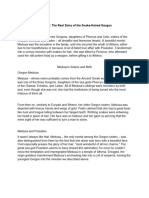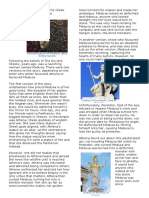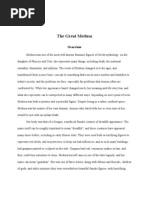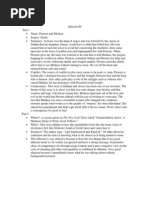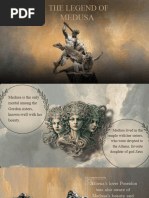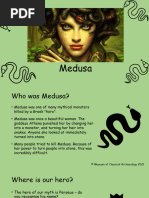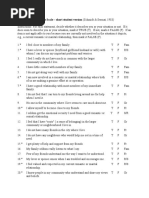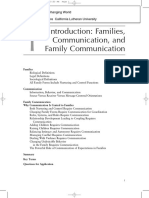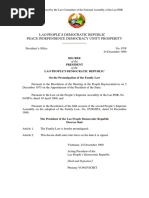0 ratings0% found this document useful (0 votes)
8 viewsMedusa. Texto Aula Giovana Ruiva 12.11
Medusa. Texto Aula Giovana Ruiva 12.11
Uploaded by
Martha GattarosaCopyright:
© All Rights Reserved
Available Formats
Download as DOCX, PDF, TXT or read online from Scribd
Medusa. Texto Aula Giovana Ruiva 12.11
Medusa. Texto Aula Giovana Ruiva 12.11
Uploaded by
Martha Gattarosa0 ratings0% found this document useful (0 votes)
8 views2 pagesCopyright
© © All Rights Reserved
Available Formats
DOCX, PDF, TXT or read online from Scribd
Share this document
Did you find this document useful?
Is this content inappropriate?
Copyright:
© All Rights Reserved
Available Formats
Download as DOCX, PDF, TXT or read online from Scribd
Download as docx, pdf, or txt
0 ratings0% found this document useful (0 votes)
8 views2 pagesMedusa. Texto Aula Giovana Ruiva 12.11
Medusa. Texto Aula Giovana Ruiva 12.11
Uploaded by
Martha GattarosaCopyright:
© All Rights Reserved
Available Formats
Download as DOCX, PDF, TXT or read online from Scribd
Download as docx, pdf, or txt
You are on page 1of 2
Medusa's tale is one of beauty turned to horror.
Originally, she was a beautiful maiden
with enviable locks. However, her life took a tragic turn following an encounter with
Poseidon in Athena's temple. This event marked the beginning of her curse and
transformation into one of Greek mythology's most recognisable and misunderstood
figures.
Medusa Before the Curse: A Ravishing Maiden
Medusa began as a breathtakingly beautiful maiden, whose locks were the envy of all
who beheld her. Known for her beauty across the land, Medusa's life was filled with
admiration and attention, setting the stage for the tragic turn her fate would soon
take.
The Fateful Encounter: Poseidon in Athena's Temple
The turning point in Medusa's life came with her encounter with Poseidon, the god of
the sea, within the sacred confines of Athena’s temple. Attracted by Medusa's beauty,
Poseidon pursued her. Medusa sought refuge in Athena's temple, hoping for
protection. However, Poseidon disregarded the temple's sanctity and assaulted
Medusa within its walls.
The Curse of Athena: Transformation and Punishment
Rather than directing her wrath at Poseidon, Athena punished Medusa, one of her
priestesses who had taken a vow of celibacy. This curse transformed her into a
creature with serpents for hair and a gaze that turned onlookers to stone. The reasons
behind Athena's curse are layered, with interpretations ranging from divine
punishment for desecrating her temple to an act of protection against further harm.
This transformation marks a shift in Medusa's story from one of admiration to one of
fear and misunderstanding.
Isolation and Tragedy
With the curse, Medusa's life turned to isolation and tragedy. No longer the object of
admiration but of fear, her existence became a symbol of the complex interplay
between beauty, power, and victimisation.
The Arrival of Perseus
Perseus’s quest to kill Medusa was a mission assigned to him as part of a larger
narrative of heroism and divine intervention. Tasked with bringing back her head to
save his mother from a forced marriage, Perseus's journey to Medusa's lair was
encouraged by gifts from the gods: winged sandals from Hermes, a reflective shield
from Athena, a sword from Hephaestus, and Hades's invisibility powers.
The Battle and Medusa’s Demise
Using the reflective shield to avoid Medusa’s direct gaze, Perseus approached the
Gorgon while she slept. In a swift, decisive movement, he used the sword to behead
Medusa, thus ending her life. This act required a strategic approach, exploiting
Medusa's vulnerability to achieve victory.
Even in death, Medusa's power did not wane. Her head, now severed from her body,
retained its petrifying gaze. Perseus used it as a weapon several times before
ultimately giving it to Athena, who placed it on her shield, the Aegis. This
transformation of Medusa from a being of terror to a symbol of protection
underscores the complex nature of her legacy.
You might also like
- Wedding Budget-Francis and ViolahDocument4 pagesWedding Budget-Francis and ViolahÈdthôn Êpísõdês Êddìê100% (4)
- Advice Upon Intended MarriageDocument2 pagesAdvice Upon Intended MarriageFrancisLayag33% (3)
- The Story of MedusaDocument2 pagesThe Story of MedusaWiwin Zahirotul Amalia67% (3)
- The Story of MedusaDocument2 pagesThe Story of MedusaMaki EspinosaNo ratings yet
- 3 EL 112 - Pandora and MedusaDocument4 pages3 EL 112 - Pandora and MedusaAngel RodriguezNo ratings yet
- MedusaDocument8 pagesMedusapierrette1No ratings yet
- The Curse of MedusaDocument2 pagesThe Curse of MedusaRichelle Anne TecsonNo ratings yet
- MedusaDocument2 pagesMedusaEmaNo ratings yet
- The Myth of Perseus and MedusaDocument1 pageThe Myth of Perseus and Medusaalex osorioNo ratings yet
- MedusaDocument4 pagesMedusagabby rielleNo ratings yet
- MedusaDocument1 pageMedusaJecca BangsaliwNo ratings yet
- Medusa UntoldDocument2 pagesMedusa UntoldElijah Loh Keng SoonNo ratings yet
- The Story of TH WPS OfficeDocument2 pagesThe Story of TH WPS Officealyssaamaro0308No ratings yet
- The Myth of Perseus and MedusaDocument6 pagesThe Myth of Perseus and Medusab2f58x9w96No ratings yet
- The Myth of MedusaDocument2 pagesThe Myth of MedusaNatasha Alia RazmanNo ratings yet
- Med UsaDocument4 pagesMed UsaElvis LeonNo ratings yet
- Perseus and Medusa - Storyboard Strips Rearrange Practice-1Document1 pagePerseus and Medusa - Storyboard Strips Rearrange Practice-1yosef.shamougNo ratings yet
- Medusa HWDocument3 pagesMedusa HWjanezhang555lNo ratings yet
- Sigreek MythologyDocument19 pagesSigreek Mythologyv2zj4rsw98No ratings yet
- MedusaDocument5 pagesMedusaMeli HanuroNo ratings yet
- Caput AlgolDocument14 pagesCaput AlgolRaphael888100% (3)
- PerseusDocument8 pagesPerseusJaden Azareah WadeNo ratings yet
- Allusion 9Document1 pageAllusion 9api-224492732No ratings yet
- MedusapaperDocument4 pagesMedusapaperapi-293988866No ratings yet
- Medusa: Suleman Touray 4C EsoDocument4 pagesMedusa: Suleman Touray 4C EsoSulemanNo ratings yet
- LITT-MIDTerm Exam, Tan, Beltran B.Document4 pagesLITT-MIDTerm Exam, Tan, Beltran B.Beltran YuanNo ratings yet
- Greek Mythology Research Annotated BibliographyDocument2 pagesGreek Mythology Research Annotated Bibliography108627No ratings yet
- Daughter of GraceDocument1 pageDaughter of Graceaverysam100No ratings yet
- Medusa and PursuesDocument2 pagesMedusa and Pursuesnosh Weissberg100% (1)
- The Story of Perseus and Medusa (Word)Document1 pageThe Story of Perseus and Medusa (Word)Amenoden NorodinNo ratings yet
- The Myth of Perseus and Medusa PDFDocument2 pagesThe Myth of Perseus and Medusa PDFAli GonzálezNo ratings yet
- Transforming MedusaDocument13 pagesTransforming Medusasegu82No ratings yet
- Medusa - PPTX 20231126 203725 0000Document6 pagesMedusa - PPTX 20231126 203725 0000toprakgnl122No ratings yet
- Medusa - Wikipedia, The Free EncyclopediaDocument7 pagesMedusa - Wikipedia, The Free Encyclopediaariman5678582No ratings yet
- PerseusDocument8 pagesPerseusJaden Azareah WadeNo ratings yet
- Greek MythsDocument3 pagesGreek Mythssdea21nNo ratings yet
- Untitled DocumentDocument7 pagesUntitled DocumenthannhNo ratings yet
- PerseusDocument5 pagesPerseusTreshiel JohnwesleyNo ratings yet
- Part 3 - Chapter 1 (Perseus)Document2 pagesPart 3 - Chapter 1 (Perseus)George Kevin TomasNo ratings yet
- Myths and Legends The Adventures of PerseusDocument4 pagesMyths and Legends The Adventures of PerseussddadhakNo ratings yet
- MedusaDocument1 pageMedusaDavidva21No ratings yet
- PERSEUSDocument4 pagesPERSEUSmizzoufurrNo ratings yet
- Project in English IIDocument2 pagesProject in English IIDaniel EnageNo ratings yet
- Perseus & AndromedaDocument4 pagesPerseus & AndromedaDanna Jean TambigaNo ratings yet
- Medusa's Curse - Google SearchDocument1 pageMedusa's Curse - Google SearchRayshandira MutiaraNo ratings yet
- The Gorgons HeadDocument4 pagesThe Gorgons HeadOne OF Those100% (1)
- MEDUSADocument2 pagesMEDUSAaverysam100No ratings yet
- The Tale of Perseus: Teacher GuideDocument15 pagesThe Tale of Perseus: Teacher GuideCarl CardozoNo ratings yet
- CLASH OF TITANSDocument4 pagesCLASH OF TITANSzfp7q49kqyNo ratings yet
- MedusaDocument7 pagesMedusazyramaesanpascual9No ratings yet
- PerseusDocument1 pagePerseusapi-272072103No ratings yet
- Perseus, The Hero's JourneyDocument2 pagesPerseus, The Hero's JourneyhhhNo ratings yet
- MedusaDocument6 pagesMedusaRefianoNo ratings yet
- The Myth of Adonis &aprhodite: Ortilano, Lyka Mae FDocument21 pagesThe Myth of Adonis &aprhodite: Ortilano, Lyka Mae FORTILANO, Lyka Mae F.No ratings yet
- Perseus and MedusaDocument1 pagePerseus and Medusaapi-296047638No ratings yet
- KidsBox Level6 Photocopiables Unit 1Document1 pageKidsBox Level6 Photocopiables Unit 1Amelia RuedaNo ratings yet
- Gorgon's Head Vs Clash of Titans - Docallos - Rhiezyn - G10-RutherfordDocument7 pagesGorgon's Head Vs Clash of Titans - Docallos - Rhiezyn - G10-RutherfordMark Lawrence Bael88% (8)
- A Classical Greek Hero - PerseusDocument5 pagesA Classical Greek Hero - Perseusnaren.littlebroNo ratings yet
- Adventures of PerseusDocument2 pagesAdventures of PerseusÑìkhíl GãürâvNo ratings yet
- Plural ExercisesDocument2 pagesPlural ExercisesmacyhumairaNo ratings yet
- doc.kátiaDocument11 pagesdoc.kátiaMartha GattarosaNo ratings yet
- Prova Lucas LodettiDocument2 pagesProva Lucas LodettiMartha GattarosaNo ratings yet
- kidsDocument1 pagekidsMartha GattarosaNo ratings yet
- taciana listening (1)Document4 pagestaciana listening (1)Martha GattarosaNo ratings yet
- atividade 25.03Document1 pageatividade 25.03Martha GattarosaNo ratings yet
- Collins 1 - test 2 (3)Document3 pagesCollins 1 - test 2 (3)Martha GattarosaNo ratings yet
- It Starts With OneDocument2 pagesIt Starts With OneMartha GattarosaNo ratings yet
- TN2 U4 AssessmentDocument7 pagesTN2 U4 AssessmentMartha GattarosaNo ratings yet
- TEST 4 tHINK 1 (2)Document2 pagesTEST 4 tHINK 1 (2)Martha GattarosaNo ratings yet
- 268 Scra 198 Digest PersonsDocument1 page268 Scra 198 Digest Personsjenifer_paglinawan100% (1)
- A Raisin in The SunDocument1 pageA Raisin in The Sunsheryl ann dionicioNo ratings yet
- The Wandering Eyes of Men and Women - Sex Differences in Motivations For InfidelityDocument20 pagesThe Wandering Eyes of Men and Women - Sex Differences in Motivations For InfidelityQuel PaivaNo ratings yet
- NCERT Solutions For Class 11 English Snapshots Chapter 3 Rangas MarriageDocument2 pagesNCERT Solutions For Class 11 English Snapshots Chapter 3 Rangas Marriageshubhamkumar405799No ratings yet
- Differential Loneliness Scale - Short Student Version (Schmidt & Sermat, 1983)Document2 pagesDifferential Loneliness Scale - Short Student Version (Schmidt & Sermat, 1983)Emiliya IvanovaNo ratings yet
- Mapula The Rain QueenDocument1,826 pagesMapula The Rain Queenmhlongonkateko070No ratings yet
- Eleosida vs. Civil Registrar of Q.CDocument1 pageEleosida vs. Civil Registrar of Q.CGraceNo ratings yet
- Mandaya: Culture of MindanaoDocument26 pagesMandaya: Culture of MindanaoMatara Ligaya Garcia100% (3)
- SF - 3 - 1 - Marriage - and - Divorce - Rates (1) - DikonversiDocument5 pagesSF - 3 - 1 - Marriage - and - Divorce - Rates (1) - DikonversirikaNo ratings yet
- Muslim LawDocument30 pagesMuslim LawAniruddha MondalNo ratings yet
- Corpus Vs Sto Tomas GR 186571Document2 pagesCorpus Vs Sto Tomas GR 186571ddrneltexNo ratings yet
- SantalDocument31 pagesSantalC Shekhar100% (1)
- A DollDocument1 pageA DollHazel Oliveros NebreNo ratings yet
- Cleopatra Selene II - WikipediaDocument5 pagesCleopatra Selene II - WikipediaHakimNo ratings yet
- Chips CH 5 Bright GrammarDocument3 pagesChips CH 5 Bright GrammarJawad KhalidNo ratings yet
- Aunt Jennifer's TigersDocument2 pagesAunt Jennifer's Tigersanilkrsahu258No ratings yet
- Dowry Prohibition Law in India by Akash NandaDocument126 pagesDowry Prohibition Law in India by Akash NandaAkash NandaNo ratings yet
- Summer Night DreamDocument10 pagesSummer Night DreamSarah FigueroaNo ratings yet
- Le Poire, 2005 - Family Communication (Chapter1)Document28 pagesLe Poire, 2005 - Family Communication (Chapter1)Viviane BarbosaNo ratings yet
- Moot Court Memorial On Divorce NewDocument12 pagesMoot Court Memorial On Divorce NewRahul Hasija100% (1)
- Maxwell (2018)Document16 pagesMaxwell (2018)mazlaineyNo ratings yet
- Lacson V LacsonDocument2 pagesLacson V LacsonG S100% (2)
- Family Law LAO75493Document16 pagesFamily Law LAO75493Edwin de KorteNo ratings yet
- About The CompanyDocument4 pagesAbout The CompanyMayank JoshiNo ratings yet
- Form L: Government of Antigua and BarbudaDocument9 pagesForm L: Government of Antigua and BarbudaMikeyNo ratings yet
- Adwokat DR Piotr Sobanski Zielona Gora Conditions For Divorce in Polish LawDocument3 pagesAdwokat DR Piotr Sobanski Zielona Gora Conditions For Divorce in Polish Lawadwokat-Zielona-Gora100% (1)
- M.V. Lopez CasesDocument6 pagesM.V. Lopez CasesmyleneNo ratings yet
- LCP4804 - ExamDocument10 pagesLCP4804 - Exameddie.sellnerNo ratings yet









